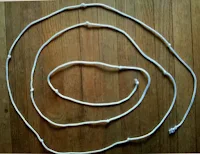This week's reading on mathematical learning through the reenactment of choreographed performance analyses of three cases in which groups of four (quartets) worked with video recordings of the 2016 Rio Olympic Games opening ceremony. Exploring how collaborative actions can foster mathematical understanding and artistic expression is fascinating. Two noteworthy "stops" in the text stand out for reflection.
First Stop: Integration of Physical Props and Collective Action: one critical aspect is emphasizing the physical engagement of quartets with the shiny plastic sheet, or Mylar, as a prop. Indeed, the quartets actively dissect and reenact movements, exploring the prop's physical possibilities. This collective manipulation of the prop becomes a medium for learning, creating geometric shapes and structures at various levels, from quartet to assembly to the entire performance. Also, integrating physical props adds a tactile dimension to the learning process, making it more immersive and engaging. The connection between physical actions and mathematical concepts, such as rotations, reflections, and translations, highlights the embodied nature of learning.
Second Stop: Ensemble Learning as a Coherent Unity: another significant aspect is the layered nature of ensemble learning, where the quartet, assembly, and whole performance levels interact dynamically. Indeed, the quartet level serves as a manageable entry point for participants, allowing them to enact critical aspects of the performance. This leads to exploring mid-level assemblies, creating geometric figures, and propagating waves. Finally, the highest-level performance unfolds with crystalline structures, liquid waves, and vortex motion. Therefore, the high level of coordination emphasizes the coherent integral unity of the performance. The quartet's engagement is not isolated; it contributes to the ensemble's significance and impact, showcasing the learning experience's collective nature.
Questions for further exploration include how physical prop interactions enhance mathematical understanding and the potential applications of this ensemble learning approach beyond dance and mathematics.
Questions for Discussion:
- How does integrating physical props, such as the Mylar sheet, enhance the learning experience for the quartets? Can you think of other examples where tangible objects contribute to mathematical understanding?
- In what ways does the layered structure of ensemble learning, from quartet to assembly to the whole performance, reflect the interconnectedness of mathematical concepts? How might this approach be applied to other disciplines beyond dance and mathematics?
Vogelstein, Brady, and Hall (2019) Reenacting mathematical concepts in large-scale dance performance
Reflection on the "Rope Polygons" Lesson:
The "Rope Polygons" lesson provides a unique and engaging approach to teaching geometry concepts, mainly focusing on measurement, reasoning with shapes, and understanding polygon properties. Indeed, I have not tried this activity. However, I would ask students to explore the properties of different polygons, such as triangles, quadrilaterals, pentagons, and hexagons. Using a twelve-foot knotted rope adds a kinesthetic and collaborative element to the learning process, making geometry come alive in a new context. The main task, challenging groups to create regular polygons with their bodies and the rope, is a hands-on and dynamic way to bridge the gap between abstract geometric concepts and real-world applications. Moreover, facilitating a whole-group conversation after the activity allows students to articulate their thought processes, share challenges, and learn from each other.
Also, I would suggest extensions for further exploration, such as investigating angle measures, side lengths, diagonals, and relationships between surface area and perimeter. This will allow for differentiation based on student readiness and interest. These extensions would encourage students to think beyond the initial challenge and deepen their understanding of geometry.
Moreover, I like allowing confusion and intervention when consensus cannot be reached. This pedagogical approach acknowledges the value of struggle in the learning process. It aligns with the idea that confusion can be a stepping stone to learning, fostering resilience and problem-solving skills. Finally, the reflective component, where students draw a picture to map out and showcase their group's approach to the challenge, is a valuable assessment tool. It reinforces their understanding and provides a visual representation of their learning journey.







Hi Tony!
ReplyDeleteI enjoyed reading your post about learning math through dance and the "Rope Polygons" lesson. It was interesting to see how using a shiny plastic sheet in dance helps with understanding math. The way the quartets played with the sheet, creating shapes and structures, sounded like a lot of fun and a great way to learn.
The "Rope Polygons" lesson with a long knotted rope to make shapes with our bodies seems like a fun way to learn about geometry. Your idea of exploring angles, side lengths, and other things after the main activity is cool too! I appreciate that you mentioned letting students figure things out, even if they get a bit confused. It's great that you see confusion as a way to learn and become better problem solvers. The part where students draw a picture to show how they solved the challenge is a smart way to see what they learned.
Your post gave me good ideas for making learning more hands-on and enjoyable. Your questions for further exploration, especially about using physical props in different ways and applying ensemble learning to other subjects, got me thinking too.
You keep posting wonderful content for the units I'm currently teaching! My students are exploring geometry for the first time in their academic careers, and they are extremely busy and high energy kids. Anything with moment and physicality not only instantly engages them, but also is more meaningful as it plays to their natural way of interacting with the classroom and the world.
ReplyDeleteI especially like your explicit valuing of struggle and disagreement. I try to create situations in math class where students check each other for errors and are prompted to provide alternate perspectives, but it is hard as a teacher sometimes to not point out inaccuracies or guide students to the right path immediately. By having your students debate and reflect, they are coming to more meaningful conclusions than just being told what to do. Thank you so much for the enlightening writeup!